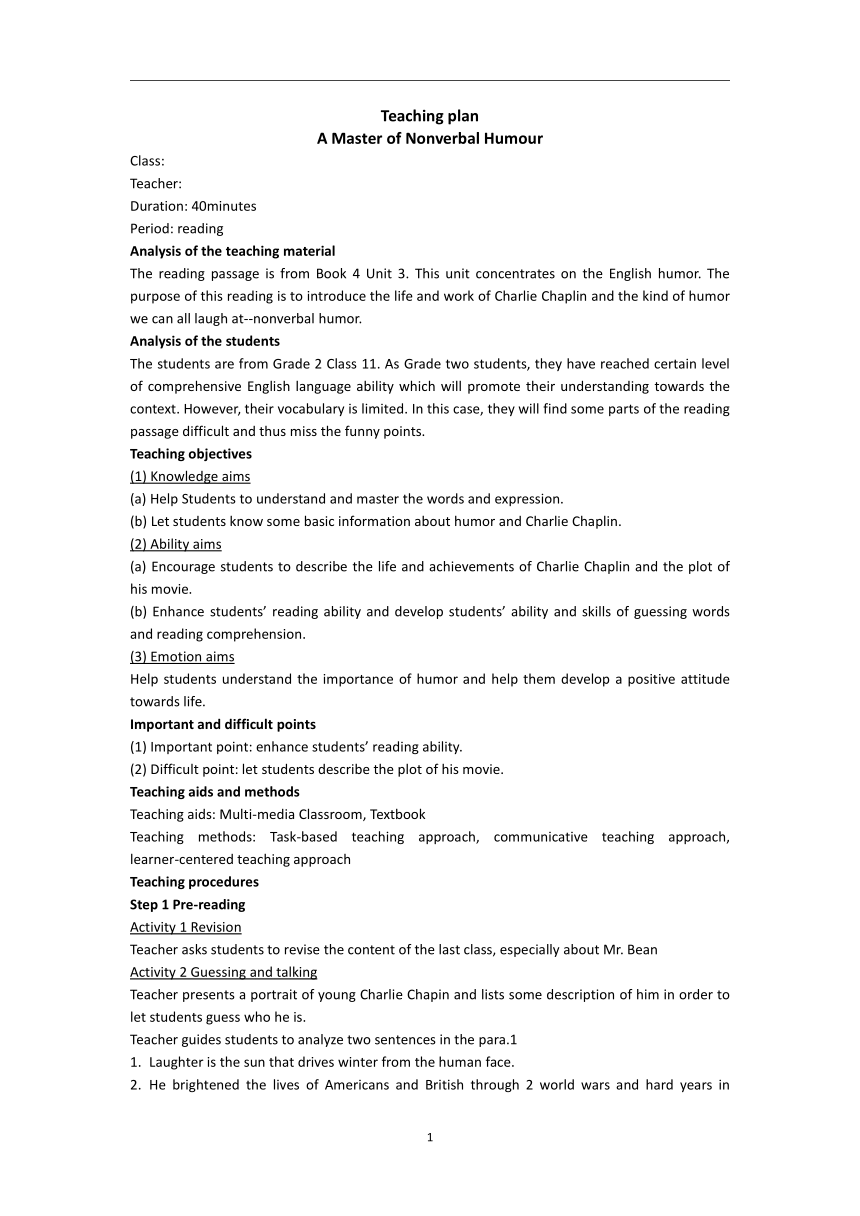人教高中英语必修四Unit 3 A taste of English humour Reading教案
文档属性
| 名称 | 人教高中英语必修四Unit 3 A taste of English humour Reading教案 |  | |
| 格式 | zip | ||
| 文件大小 | 338.6KB | ||
| 资源类型 | 教案 | ||
| 版本资源 | 人教版(新课程标准) | ||
| 科目 | 英语 | ||
| 更新时间 | 2019-10-19 16:01:15 | ||
图片预览

文档简介
Teaching plan
A Master of Nonverbal Humour
Class:
Teacher:
Duration: 40minutes
Period: reading
Analysis of the teaching material
The reading passage is from Book 4 Unit 3. This unit concentrates on the English humor. The purpose of this reading is to introduce the life and work of Charlie Chaplin and the kind of humor we can all laugh at--nonverbal humor.
Analysis of the students
The students are from Grade 2 Class 11. As Grade two students, they have reached certain level of comprehensive English language ability which will promote their understanding towards the context. However, their vocabulary is limited. In this case, they will find some parts of the reading passage difficult and thus miss the funny points.
Teaching objectives
(1) Knowledge aims
(a) Help Students to understand and master the words and expression.
(b) Let students know some basic information about humor and Charlie Chaplin.
(2) Ability aims
(a) Encourage students to describe the life and achievements of Charlie Chaplin and the plot of his movie.
(b) Enhance students’ reading ability and develop students’ ability and skills of guessing words and reading comprehension.
(3) Emotion aims
Help students understand the importance of humor and help them develop a positive attitude towards life.
Important and difficult points
(1) Important point: enhance students’ reading ability.
(2) Difficult point: let students describe the plot of his movie.
Teaching aids and methods
Teaching aids: Multi-media Classroom, Textbook
Teaching methods: Task-based teaching approach, communicative teaching approach, learner-centered teaching approach
Teaching procedures
Step 1 Pre-reading
Activity 1 Revision
Teacher asks students to revise the content of the last class, especially about Mr. Bean
Activity 2 Guessing and talking
Teacher presents a portrait of young Charlie Chapin and lists some description of him in order to let students guess who he is.
Teacher guides students to analyze two sentences in the para.1
Laughter is the sun that drives winter from the human face.
He brightened the lives of Americans and British through 2 world wars and hard years in between.
Step 2 While-reading
Activity 1 Skimming
Teaching lets students to skim the passage quickly and match the main idea of each paragraph.
Activity 2 Close-reading
Teacher asks students to read the text carefully and choose one star to answer one question.
Each question is listed as follows.
Why could people feel more content with their lives when they felt depressed during the world war?
Because Charlie made people laugh and brightened their lives.
When was Charlie taught to sing and dance?
He was taught to sing as soon as he could speak and dance as soon as he could walk.
What was Charlie’s childhood like?
He was taught to sing and dance as soon as he could walk and speak.
His father died, leaving the family even worse off.
He spent his childhood looking after his sick mother and brother.
Why was the character of the little tramp loved by people?
The character was loved for his optimism and determination to overcome all difficulties.
Please describe his most famous character.
Describe the actions. Read para. 4, and find out the verbs. Watch the pictures the use “First, then, finally” to describe his actions. Act them out.
True or False
Charlie usually made a sad situation entertaining. T
How? He could mine and act the fool doing ordinary everyday tasks.
What is the style of writing? Narration
What is the way of writing? In the order of time.
Step 3 post-reading
Activity 1 Discussion
What makes Chaplin a master and the sun at that time?
Subtle acting skills; convincing acting(talent +hard work)
Good personalities (humor, confidence, love and passion, optimism, determination...)
Activity 2 Enjoy a poem
Step 4 homework
After class, please write an 80-word article to introduce Charlie Chaplin to your friends, don’t forget mention his famous character – the little tramp.
Assessment
This class focuses on enhancing students’ reading skills especially for finding detailed information. In the close-reading part, I designed the activity in the form of a self-challenge game which may promote students’ enthusiasm and improve the participation. However, this part may take too much time and students may feel reluctant to take part in.
同课章节目录
